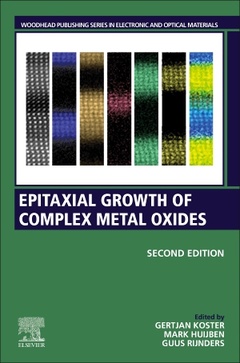Description
Epitaxial Growth of Complex Metal Oxides (2nd Ed.)
Woodhead Publishing Series in Electronic and Optical Materials Series
Coordinators: Koster Gertjan, Huijben Mark, Rijnders Guus
Language: English
Subjects for Epitaxial Growth of Complex Metal Oxides:
Keywords
Adsorption-controlled growth; Ceramic; Charge transfer; Complex metal oxides; Complex oxide growth; Complex oxides; Complex transition metal oxides; Complexity; Conductivity relaxation; Correlated electron systems; CSD; Cuprates; Defects; EDX; EELS; Electrodynamic properties; Electron diffraction; Electronic structure; Electrostriction; Emergence; Epitaxial; Epitaxial films; Epitaxy; Ferroelectric; Ferroelectric critical thickness; Ferroionics; Growth window; Heterointerface; Heterostructures; High-Tc superconductors; HMBE; HRTEM; Hybrid molecular beam epitaxy; In-situ deposition monitoring and control; Insitu; Interface effects; Interface engineering; Interfaces; Ion transport; Ionotronics; Magnetism; Manganites; MEMS; Metal-organic; Mismatch; MOD; Molecular beam epitaxy; Multifunctional electronics; Nanoionics; Nonstoichiometry
532 p. · 15.2x22.8 cm · Paperback
Description
/li>Contents
/li>Biography
/li>Comment
/li>
Epitaxial Growth of Complex Metal Oxides, Second Edition reviews techniques and recent developments in the fabrication quality of complex metal oxides, which are facilitating advances in electronic, magnetic and optical applications. Sections review the key techniques involved in the epitaxial growth of complex metal oxides and explore the effects of strain and stoichiometry on crystal structure and related properties in thin film oxides. Finally, the book concludes by discussing selected examples of important applications of complex metal oxide thin films, including optoelectronics, batteries, spintronics and neuromorphic applications.
This new edition has been fully updated, with brand new chapters on topics such as atomic layer deposition, interfaces, STEM-EELs, and the epitaxial growth of multiferroics, ferroelectrics and nanocomposites.
Part 1 Epitaxial growth techniques 1. Molecular beam epitaxy for the growth of complex oxide materials 2. Physical vapour deposition for the growth of complex oxide materials 3. Chemical vapour deposition for the growth of complex oxide materials 4. Pulsed laser deposition for the growth of complex metal oxides 5. Sputtering of complex metal oxides 6. Synthesis and surface engineering of complex metal oxides by atomic layer deposition 7. Hybrid molecular beam epitaxy for the growth of complex metal oxide materials 8. High pressure synthesis of transition metal oxides
Part 2 Epitaxial growth and functional properties of complex metal oxides 9. Epitaxial growth of ferroelectrics and multiferroics 10. Growth study of epitaxial oxide thin films using Reflection high-energy electron diffraction (RHEED) 11. Epitaxial growth of piezoelectrics 12. Epitaxial growth of superconducting oxides 13. Epitaxial growth of magnetic oxide thin films 14. Strain engineering during epitaxial growth of complex metal oxides 15. Defects, impurities and transport phenomenon in complex oxide crystals 16. In situ x-ray scattering of epitaxial oxide thin films 17. Scanning probe microscopy (SPM) of epitaxial oxide thin films
Part 3 Applications of complex metal oxides 18. Optoelectronics: an application of complex metal oxides 19. Spintronics: an application of complex metal oxides 20. Thermoelectric complex metal oxides 21. Solid oxide fuel cells based complex metal oxides 22. Applications of complex metal oxides in catalysis 23. PiezoMEMS based on complex metal oxides
Mark Huijben is a Professor at the University of Twente in the Netherlands. He is also a Guest Scientist of the IEK-1 Electrochemical Storage Department at Forschungszentrum Jülich in Germany. His research currently focuses on nanostructured thin films for advanced energy conversion and storage.
Guus Rijnders is a Professor and Chairman of Inorganic Materials Science, University of Twente, Enschede, Netherlands. His research currently focuses on the integration of functional and smart materials with electronic and microelectromechanical systems (MEMS).
- Examines the techniques used in epitaxial thin film growth for complex oxides, including atomic layer deposition, sputtering techniques, molecular beam epitaxy, and chemical solution deposition techniques
- Reviews materials design strategies and materials property analysis methods, including the impacts of defects, strain, interfaces and stoichiometry
- Describes key applications of epitaxially grown metal oxides, including optoelectronics, batteries, spintronics and neuromorphic applications




